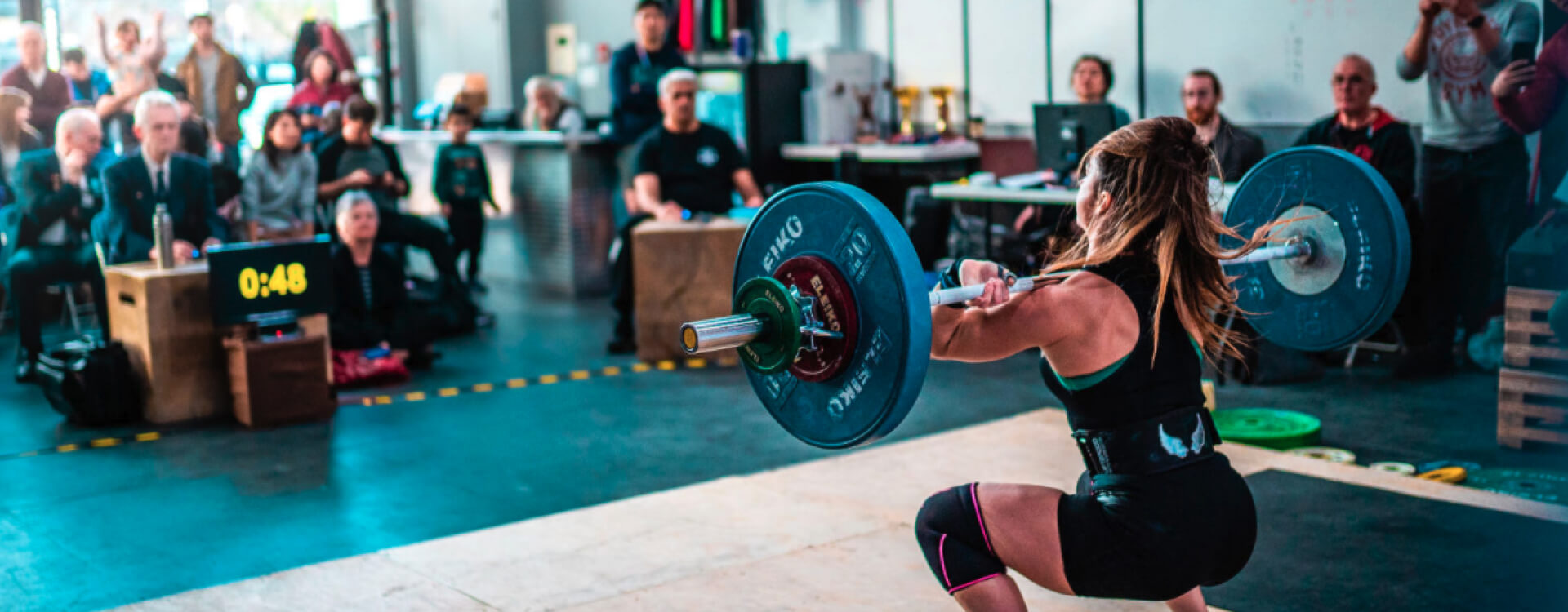In competitive Olympic Weightlifting, there are two lifts contested – the Snatch, and the Clean & Jerk.
Each athlete has three attempts at each lift, and the sum of their best Snatch and best Clean & Jerk is their Total. The goal is to execute a proper lift with as heavy a weight as possible. If there is a tie, the lifter to achieve the total first is given the higher rank.
In both the Snatch and the Clean & Jerk, once the weight is lifted the athlete must wait until the referee gives the down signal to lower the weight. The lifter must demonstrate control and stability of the bar; otherwise, the referees will declare a “no lift” ruling and the lift will be deemed as a failed attempt.
The Snatch
The Snatch is the first lift performed, and is considered by many to be the most challenging. The barbell must be lifted from the floor to above the lifter’s head in a single, fluid motion. When the weight is received overhead the arms must be kept straight and locked, any bend in the elbows with a press out will result in a disqualification of the lift.
In executing a successful Snatch, the lifter will initially lift the barbell with a powerful movement of legs and hips. Once the bar has reached chest level, the lifter will quickly pull his or her body downward and under the barbell. When the weight is received in the bottom position and is under control, the athlete stands up using the strength of the legs until the final standing position.

Clean & Jerk
The second lift is the Clean & Jerk, which is executed in a two-step process. In the “Clean”, the lifter starts with the barbell at rest on the floor, with the strength of the legs, pulls the weight to his or her shoulders in a single motion while receiving the weight in a squat position, and stands upright.
For the second half of the lift, the “Jerk”, the bar is raised to an overhead position with arms fully extended and elbows locked. The athlete dips slightly with the bar on the shoulders and then drives the weight upwards, forcefully, and then receives the weight in the split position (one foot forward, one foot back) or both feet out to the side, to maintain balance. Once the athlete has the weight under control, overhead, the lifter brings the feet in line, maintaining control of the weight throughout, into the final position.

Watching an Event
Men compete in nine weight categories (55kg, 61kg, 73kg, 81kg, 89kg, 96kgk 102kg, 109kg and 109+k) and Women in ten weight categories (45kg, 49kg, 55kg, 59kg, 64kg, 71kg, 76kg, 81kg, 87kg, 87+kg). A competition takes place with two lifts contested, the Snatch and the Clean & Jerk. Each athlete receives three attempts in each lift with the overall champion being crowned, by adding the best lift from each to reach a combined result (Total). First the Snatch is contested and once all attempts are completed, there is a 10 minute break so the athletes can prepare for the Clean & Jerk. It is considered proper etiquette for spectators to be silent once an athlete reaches the competition platform.
Each lifter has three attempts in both the Snatch and Clean & Jerk. The barbell is loaded progressively and attempts are taken by the lifters in the order of progression of the weight and the order of lifting. A Lot Number is assigned prior to the Official Weigh-In, which determines the Weigh-In and Lifting order. The athletes are called upon individually by a speaker (Announcer) to perform the attempts and they have one minute (two minutes if following themselves) to start the lift. The barbell must pass the knees before time runs out. If the time runs out and the barbell has not passed the knees, then this is judged as “No Lift”. Three Referees judge each lift and give a decision, white for “Good Lift” and red for “No Lift”. At least two out of three Referees must judge it as a “Good Lift” to have the lift count. Electronic Referee Light Systems are used for judging and two out of the three Referees decisions must be the same for the athlete to receive the “Down Signal”. Decisions must be made quickly by the Referees so that the athlete does not have to stand too long with the weight overhead. After a first attempt has been taken by an athlete, they must increase by a minimum of two kilograms for their second attempt and a minimum of one kilogram for their third attempt.
In bigger events (National and International), a Jury of five Officials oversees the three Referees and may reverse a decision of the Referees if all five unanimously agree to do so. When a lifter fails to complete one good lift in either the Snatch or the Clean & Jerk, this is considered a “Bomb Out” and the lifter receives a zero result in Total. In events where medals and team points can be garnered in both lifts and the Total, an athlete who “Bombs Out” can still win a medal in either the Snatch or Clean & Jerk, plus score team points. In the case of identical results, the athlete who performs the result first, receives the higher ranking.
View Upcoming Events
